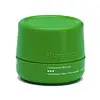What's inside
What's inside
 Key Ingredients
Key Ingredients

 Benefits
Benefits

 Concerns
Concerns

 Ingredients Side-by-side
Ingredients Side-by-side

Water
Skin ConditioningGlycerin
HumectantCaprylic/Capric Triglyceride
MaskingGlyceryl Stearate Se
EmulsifyingIsononyl Isononanoate
EmollientCetearyl Alcohol
EmollientPentylene Glycol
Skin ConditioningPalmitic Acid
EmollientOryza Sativa Bran Water
MaskingTremella Fuciformis Sporocarp Extract
AntioxidantSqualane
EmollientSodium Hyaluronate
HumectantNiacinamide
SmoothingPyrus Malus Fruit Extract
Skin ConditioningCentella Asiatica Leaf Extract
Skin ConditioningLactobacillus Ferment
Skin ConditioningCocos Nucifera Fruit Juice
EmollientCocos Nucifera Water
MaskingBetaine
HumectantStearic Acid
CleansingTocopheryl Acetate
AntioxidantMaltodextrin
AbsorbentCarbomer
Emulsion StabilisingTrisodium Ethylenediamine Disuccinate
Potassium Sorbate
PreservativeSodium Benzoate
MaskingSodium Anisate
AntimicrobialSodium Levulinate
Skin ConditioningMyristic Acid
CleansingPhenoxyethanol
PreservativeEthylhexylglycerin
Skin ConditioningPotassium Hydroxide
BufferingXanthan Gum
EmulsifyingWater, Glycerin, Caprylic/Capric Triglyceride, Glyceryl Stearate Se, Isononyl Isononanoate, Cetearyl Alcohol, Pentylene Glycol, Palmitic Acid, Oryza Sativa Bran Water, Tremella Fuciformis Sporocarp Extract, Squalane, Sodium Hyaluronate, Niacinamide, Pyrus Malus Fruit Extract, Centella Asiatica Leaf Extract, Lactobacillus Ferment, Cocos Nucifera Fruit Juice, Cocos Nucifera Water, Betaine, Stearic Acid, Tocopheryl Acetate, Maltodextrin, Carbomer, Trisodium Ethylenediamine Disuccinate, Potassium Sorbate, Sodium Benzoate, Sodium Anisate, Sodium Levulinate, Myristic Acid, Phenoxyethanol, Ethylhexylglycerin, Potassium Hydroxide, Xanthan Gum
Water
Skin ConditioningPropylene Glycol
HumectantDicaprylyl Ether
EmollientGlycerin
HumectantPEG-100 Stearate
Glyceryl Stearate
EmollientSqualene
EmollientHydrogenated Polyisobutene
EmollientPhenoxyethanol
PreservativeSorbitan Oleate
EmulsifyingCaprylyl Glycol
EmollientAcrylates/C10-30 Alkyl Acrylate Crosspolymer
Emulsion StabilisingTriethanolamine
BufferingBeeswax
Emulsion StabilisingTocopherol
AntioxidantDisodium EDTA
Stearic Acid
CleansingMyristyl Alcohol
EmollientPrunus Amygdalus Dulcis Oil
Skin ConditioningPrunus Armeniaca Kernel Oil
MaskingElaeis Guineensis Kernel Oil
EmollientPersea Gratissima Oil
Skin ConditioningWater, Propylene Glycol, Dicaprylyl Ether, Glycerin, PEG-100 Stearate, Glyceryl Stearate, Squalene, Hydrogenated Polyisobutene, Phenoxyethanol, Sorbitan Oleate, Caprylyl Glycol, Acrylates/C10-30 Alkyl Acrylate Crosspolymer, Triethanolamine, Beeswax, Tocopherol, Disodium EDTA, Stearic Acid, Myristyl Alcohol, Prunus Amygdalus Dulcis Oil, Prunus Armeniaca Kernel Oil, Elaeis Guineensis Kernel Oil, Persea Gratissima Oil
Ingredients Explained
These ingredients are found in both products.
Ingredients higher up in an ingredient list are typically present in a larger amount.
Glycerin is already naturally found in your skin. It helps moisturize and protect your skin.
A study from 2016 found glycerin to be more effective as a humectant than AHAs and hyaluronic acid.
As a humectant, it helps the skin stay hydrated by pulling moisture to your skin. The low molecular weight of glycerin allows it to pull moisture into the deeper layers of your skin.
Hydrated skin improves your skin barrier; Your skin barrier helps protect against irritants and bacteria.
Glycerin has also been found to have antimicrobial and antiviral properties. Due to these properties, glycerin is often used in wound and burn treatments.
In cosmetics, glycerin is usually derived from plants such as soybean or palm. However, it can also be sourced from animals, such as tallow or animal fat.
This ingredient is organic, colorless, odorless, and non-toxic.
Glycerin is the name for this ingredient in American English. British English uses Glycerol/Glycerine.
Learn more about GlycerinPhenoxyethanol is a preservative that has germicide, antimicrobial, and aromatic properties. Studies show that phenoxyethanol can prevent microbial growth. By itself, it has a scent that is similar to that of a rose.
It's often used in formulations along with Caprylyl Glycol to preserve the shelf life of products.
Stearic Acid is a fatty acid. It is an emollient, emulsifier, and texture enhancer.
As an emollient, stearic acid helps soften skin. It aids the skin's protective barrier by preventing water loss. It also provides a gentle cleansing effect without stripping away natural oils.
Stearic acid may also be used to enhance the texture of products. It can add volume and stabilize ingredients such as water and oil. This can help water and oil ingredients from separating.
Sources of stearic acid include animal or vegetable fats/oils such as coconut or shea. It can be naturally found in butter, cocoa butter, shea butter, vegetable fats, and animal tallow.
This ingredient may not be Malassezia folliculitis, or fungal-acne safe.
Learn more about Stearic AcidWater. It's the most common cosmetic ingredient of all. You'll usually see it at the top of ingredient lists, meaning that it makes up the largest part of the product.
So why is it so popular? Water most often acts as a solvent - this means that it helps dissolve other ingredients into the formulation.
You'll also recognize water as that liquid we all need to stay alive. If you see this, drink a glass of water. Stay hydrated!
Learn more about Water